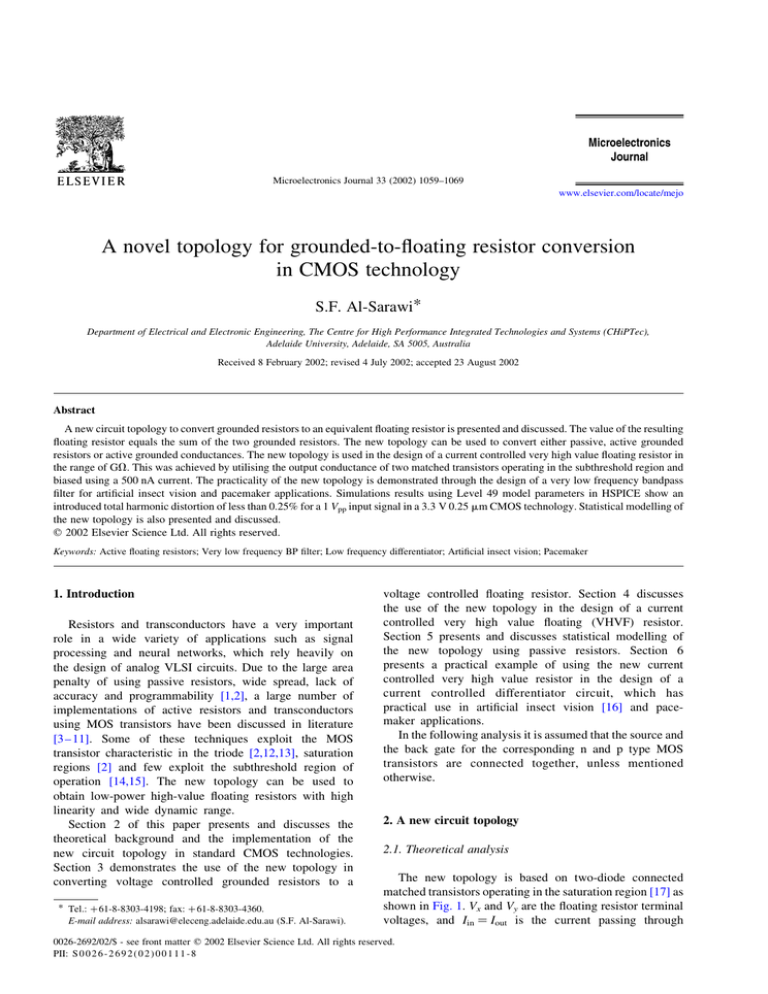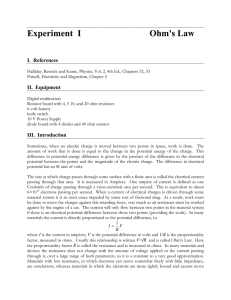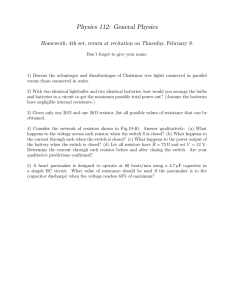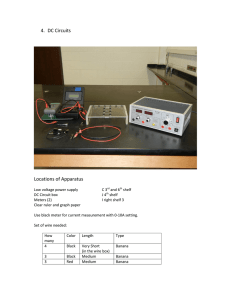
Microelectronics Journal 33 (2002) 1059–1069
www.elsevier.com/locate/mejo
A novel topology for grounded-to-floating resistor conversion
in CMOS technology
S.F. Al-Sarawi*
Department of Electrical and Electronic Engineering, The Centre for High Performance Integrated Technologies and Systems (CHiPTec),
Adelaide University, Adelaide, SA 5005, Australia
Received 8 February 2002; revised 4 July 2002; accepted 23 August 2002
Abstract
A new circuit topology to convert grounded resistors to an equivalent floating resistor is presented and discussed. The value of the resulting
floating resistor equals the sum of the two grounded resistors. The new topology can be used to convert either passive, active grounded
resistors or active grounded conductances. The new topology is used in the design of a current controlled very high value floating resistor in
the range of GV. This was achieved by utilising the output conductance of two matched transistors operating in the subthreshold region and
biased using a 500 nA current. The practicality of the new topology is demonstrated through the design of a very low frequency bandpass
filter for artificial insect vision and pacemaker applications. Simulations results using Level 49 model parameters in HSPICE show an
introduced total harmonic distortion of less than 0.25% for a 1 Vpp input signal in a 3.3 V 0.25 mm CMOS technology. Statistical modelling of
the new topology is also presented and discussed.
q 2002 Elsevier Science Ltd. All rights reserved.
Keywords: Active floating resistors; Very low frequency BP filter; Low frequency differentiator; Artificial insect vision; Pacemaker
1. Introduction
Resistors and transconductors have a very important
role in a wide variety of applications such as signal
processing and neural networks, which rely heavily on
the design of analog VLSI circuits. Due to the large area
penalty of using passive resistors, wide spread, lack of
accuracy and programmability [1,2], a large number of
implementations of active resistors and transconductors
using MOS transistors have been discussed in literature
[3 – 11]. Some of these techniques exploit the MOS
transistor characteristic in the triode [2,12,13], saturation
regions [2] and few exploit the subthreshold region of
operation [14,15]. The new topology can be used to
obtain low-power high-value floating resistors with high
linearity and wide dynamic range.
Section 2 of this paper presents and discusses the
theoretical background and the implementation of the
new circuit topology in standard CMOS technologies.
Section 3 demonstrates the use of the new topology in
converting voltage controlled grounded resistors to a
* Tel.: þ61-8-8303-4198; fax: þ 61-8-8303-4360.
E-mail address: alsarawi@eleceng.adelaide.edu.au (S.F. Al-Sarawi).
voltage controlled floating resistor. Section 4 discusses
the use of the new topology in the design of a current
controlled very high value floating (VHVF) resistor.
Section 5 presents and discusses statistical modelling of
the new topology using passive resistors. Section 6
presents a practical example of using the new current
controlled very high value resistor in the design of a
current controlled differentiator circuit, which has
practical use in artificial insect vision [16] and pacemaker applications.
In the following analysis it is assumed that the source and
the back gate for the corresponding n and p type MOS
transistors are connected together, unless mentioned
otherwise.
2. A new circuit topology
2.1. Theoretical analysis
The new topology is based on two-diode connected
matched transistors operating in the saturation region [17] as
shown in Fig. 1. Vx and Vy are the floating resistor terminal
voltages, and Iin ¼ Iout is the current passing through
0026-2692/02/$ - see front matter q 2002 Elsevier Science Ltd. All rights reserved.
PII: S 0 0 2 6 - 2 6 9 2 ( 0 2 ) 0 0 1 1 1 - 8
1060
S.F. Al-Sarawi / Microelectronics Journal 33 (2002) 1059–1069
2.2. Topology implementation
A possible implementation of Eqs. (6) and (7), is shown in
Fig. 2. In this topology the current passing through mn1 is
mirrored by mn2 and feeds back to the Vy terminal of mn3 using
mp1. In a similar way, the current passing through mn3 is
mirrored by mn4 and feeds back to the Vx terminal of mn1 using
mp3. The relation between Vx and V1, while assuming a passive
resistor connected between V1 and ground, can be written as
V1 ¼ Rð2I2 Þ ¼ KRðVx 2 V1 2 Vth Þ2 ;
Fig. 1. The basic MOS transistor cell.
the terminals. The current equation for the transistors in
Fig. 1 can be written as
K
ðV 2 V2 2 Vth Þ2 ;
2 y
K
I2 ¼ ðVx 2 V1 2 Vth Þ2 ;
2
I1 ¼
ð1Þ
ð2Þ
where K is defined as mo Cox ðW=LÞ; mo, the carrier mobility;
Cox, the oxide capacitance per unit area; Vth, the MOS
transistor threshold voltage and W=L is the width to length
ratio of the transistor. The current passing through the
circuit topology can be written as
Iin ¼ Iout ¼ I2 2 I1 :
ð3Þ
Substituting Eqs. (1) and (2) into Eq. (3), and simplifying
the results, Iout can be written as
Iout ¼
K
½ðVx 2 Vy Þ 2 ðV1 2 V2 Þ½ðVx þ Vy Þ
2
2 ðV1 þ V2 Þ 2 2Vth :
ð4Þ
The equivalent resistance, Reqv, is defined as
Reqv ¼
Vx 2 Vy
Vx 2 Vy
¼
:
Iin
Iout
ð11Þ
where R is the resistor value. Solving Eq. (11) for V1 gives two
solutions, the feasible one is
pffiffiffiffiffiffiffiffiffiffiffiffiffiffiffiffiffiffiffiffiffiffiffi
1 2 1 þ 2KRðVx 2 Vth Þ
:
ð12Þ
V1 ¼ Vx 2 Vth þ
2KR
A similar expression for V2 can be written as
pffiffiffiffiffiffiffiffiffiffiffiffiffiffiffiffiffiffiffiffiffiffiffi
1 2 1 þ 2KRðVy 2 Vth Þ
:
V2 ¼ Vy 2 Vth þ
2KR
ð13Þ
Comparing Eqs. (12) and (13) with Eqs. (6) and (7),
respectively, f ðVx Þ and f ðVy Þ can be written as
pffiffi
12 X
f ðVx Þ ¼
;
ð14Þ
2KR
pffiffi
12 Y
;
ð15Þ
f ðVy Þ ¼
2KR
where
X ¼ 1 þ 2KRðVx 2 Vth Þ and Y ¼ 1 þ 2KRðVy 2 Vth Þ:
Substituting the values of f ðVx Þ and f ðVy Þ from Eqs. (14) and
(15) in Eq. (10), Iout can be written as
pffiffi
pffiffi
1
½ð1 2 X Þ2 2 ð1 2 Y Þ2 :
ð16Þ
Iout ¼
2
8KR
ð5Þ
In order to achieve a circuit topology independent of the
MOS transistor threshold voltage, let
V1 ¼ Vx 2 Vth þ f ðVx Þ;
ð6Þ
V2 ¼ Vy 2 Vth þ f ðVy Þ:
ð7Þ
The sum and the difference of V1 and V2 can be written as
V1 þ V2 ¼ Vx þ Vy 2 2Vth þ f ðVx Þ þ f ðVy Þ;
ð8Þ
V1 2 V2 ¼ Vx 2 Vy þ f ðVx Þ 2 f ðVy Þ:
ð9Þ
By substituting Eqs. (8) and (9) in Eq. (4), Iout can be written
as
Iout ¼
K
ðf ðVx Þ2 2 f ðVy Þ2 Þ:
2
ð10Þ
Eq. (10) shows that the current passing through the topology
is independent of the MOS transistor threshold voltage, a
square function of Vx and Vy and is proportional to K.
Fig. 2. The new topology with two passive resistor connected at V1 and V2
and ground.
S.F. Al-Sarawi / Microelectronics Journal 33 (2002) 1059–1069
1061
Fig. 3. The simulation results of the new circuit topology with two 1 MV passive resistors connected at V1 and at V2.
pffiffi
pffiffi
Assuming X q 1 and Y q 1; which is a valid assumption
for large values of R, then Eq. (16) is reduced to
Iout ¼
1
ðX 2 YÞ:
8KR2
ð17Þ
Substituting the values of X and Y in Eq. (17), with Vx ¼
VB þ Vin =2 and Vy ¼ VB 2 Vin =2; Eq. (17) is reduced to
Iout ¼
Vin
:
2R
Fig. 4. The frequency response of the new circuit topology with two 1 MV passive resistors connected at V1 and V2.
ð18Þ
1062
S.F. Al-Sarawi / Microelectronics Journal 33 (2002) 1059–1069
Fig. 5. THD introduced by the new circuit topology as function of the input signal amplitude.
An expression for the equivalent resistance Reqv can be
written by substituting Eq. (18) into Eq. (5), as given by
Reqv ¼
Vin
¼ 2R:
Iout
ð19Þ
Eq. (19) shows that the equivalent floating resistor value is
independent of the process model parameters and the
threshold voltage of the MOS transistor. Eq. (19) also
shows that the V –I relation of this topology resembles an
ideal resistor with an equivalent floating resistor equal to the
sum of the grounded resistors.
The circuit shown in Fig. 2 was simulated with the length
and width of all transistor sizes are set to 12 mm as shown in
Fig. 3. These simulations were conducted using HSPICE
simulator with Level 49 process model parameters for
0.25 mm single poly, 5 metal n-well process. The simulated
I– V characteristics with passive input resistors show a very
wide dynamic range and very linear characteristics. The
frequency response of the topology using passive resistors is
shown in Fig. 4. The AC simulations show a frequency
response that extends to the MHz range with constant
resistance value. The introduced total harmonic distortion
(THD) by the new topology for 1 Vpp input signal is less than
0.25% as shown in Fig. 5.
grounded resistors or conductances. As an example,
the grounded resistor [18] shown in Fig. 6 is used. This
grounded resistor was chosen because of its simplicity,
very high linearity and controllability. Other grounded
resistors such as the ones described in Refs. [6,19] can
also be used.
The resistor shown in Fig. 6 was simulated using the
previously mentioned technology, with W1 =L1 ¼ 48 mm/
6 mm and W2 =L2 ¼ 6 mm/48 mm. The control voltage Vc
was swept from 1 to 3.5 V in a 0.5 V step, while V0 was
swept from 0 to 5 V for every Vc, as shown in Fig. 7.
The resistor shown in Fig. 6, was integrated in the new
topology as shown in Fig. 8, and simulated with all
transistor sizes in the topology and the grounded resistors
are kept as before. The simulation results for the new
3. Converting a grounded resistor to a floating resistor
The analysis presented in Section 2 is still also valid
when the passive resistors are replaced by active
Fig. 6. A very linear grounded resistor.
S.F. Al-Sarawi / Microelectronics Journal 33 (2002) 1059–1069
1063
Fig. 7. Simulation results of the grounded resistor shown in Fig. 6 with the control voltage Vc swept from 1 to 3.5 V in a 0.5 V step.
floating resistor are shown in Fig. 9. The figure shows
that the resultant voltage controlled floating resistor is
also very linear.
current configuration can be used instead of the two
transistor current mirrors. Using the simple transistor
model that includes the channel length modulation effect,
the output conductances, gd of mn5 or mn6 at constant gate
4. Very high value floating resistor
A VHVF resistor can be designed using the previous
topology if starting with very high value resistors or output
conductances. To demonstrate the technique with a high
output conductance configuration, the output conductance
of the MOS transistor in the saturation region is used as
shown in Fig. 10. A MOS transistor biased with small value
current provides a very high output conductance in the range
of GV. The main concern about using the MOS transistor
output conductance is that it depends on the channel length
modulation parameter l, which is defined [20] as
rffiffiffiffiffiffiffiffiffiffiffiffiffiffiffiffiffiffiffiffiffiffiffiffi
1si
qNeff ðVDS 2 VDsat Þ
l¼
;
ð20Þ
L
where drain saturation voltage VDsat is defined as Vgs 2 Vth ;
1si is the dielectric constant of silicon, Neff is the substrate
doping density, q is the electron charge, VDS is the drain to
source voltage and L is the transistor length. From Eq. (20),
it is clear that l is a process dependent parameter and it is
not a favourable parameter to use in circuit design.
However, such dependence does not exclude l as a design
parameter [21], and in this case the dependence on l can be
compensated for by the current programmability of the
VHVF resistor. Furthermore, other high output conductance
Fig. 8. A voltagecontrolledfloating resistorgeneratedby replacingthe passive
resistors in Fig. 2 with two matched voltage controlled grounded resistors.
1064
S.F. Al-Sarawi / Microelectronics Journal 33 (2002) 1059–1069
Fig. 9. Simulation results of the new voltage controlled floating resistor shown in Fig. 8 with the control voltage Vc was swept from 1 to 2.2 V in a 0.3 V step.
to source voltage is given by
lId
gd ¼
. lId :
ð21Þ
ð1 þ lVds Þ
For an Id ¼ 1 mA and l ¼ 1 mV21 (extracted from the
Level 49 model parameters at 1 mA bias current), the
equivalent floating resistor is 2 GV.
The circuit shown in Fig. 10 was simulated using a large
value of reference current in the mA range, to demonstrate
the circuit performance when transistors are operating in the
saturation region. The simulation results, with the reference
current I0 was swept from 7.5 to 20 mA in a 2.5 mA step, are
shown in Fig. 11. The circuit shown in Fig. 10 was
resimulated using a small bias current in the nA range, to
ensure that all transistors are operating in the subthreshold
region of operation. The simulation results, with I0 was
swept from 500 nA to 1 mA in a 100 nA step, are shown in
Fig. 12. Figs. 11 and 12 show that the resistor exhibits very
linear characteristics in saturation and subthreshold regions
of operation. The frequency response of the very high value
resistor is shown in Fig. 13. The simulations show that the
bandwidth of the active floating resistor is reduced
compared to the passive floating resistor case presented
earlier with constant resistance. The reduction significance
is application dependence. For the targeted applications the
bandwidth is still within the operational frequency range.
This analysis provides an insight into the topology
sensitivity to process parameters. This section addresses
issues related to (i) threshold voltage mismatch effect on
the resultant equivalent floating resistor, (ii) transistor
dimension effect on the equivalent resistor value. These
effects are evaluated using Level 49 model parameters
5. Statistical modelling
To evaluate the performance of the circuit topology
discussed in Section 2 Monte Carlo analysis was performed.
Fig. 10. A very high value current controlled floating resistor that uses
output conductance of MOS transistor operating in the saturation region of
operation.
S.F. Al-Sarawi / Microelectronics Journal 33 (2002) 1059–1069
1065
Fig. 11. The simulation results of the current controlled VHVF resistor with the reference current I0 swept from 7.5 to 20 mA in 2.5 mA step.
for an industrial 0.25 mm CMOS process. In the
following simulations passive resistors are used as input
for the topology.
Monte Carlo analysis in HSPICE simulator is used to
show the effect of threshold voltage mismatch on the
resistor value. The simulation was conducted by adding a
small voltage to the threshold voltage calculated by
the simulator. A Gaussian distribution with zero mean
and a 5-mV standard deviation was used. The 5 mV
value was chosen based on the relation between
Fig. 12. The simulation results of the VHVF resistor with the reference current I0 swept from 500 nA to 1 mA in a 200 nA step.
1066
S.F. Al-Sarawi / Microelectronics Journal 33 (2002) 1059–1069
Fig. 13. The frequency response of the VHVF resistor with the reference current I0 swept from 500 nA to 1 mA in a 200 nA step.
transistors area and threshold voltage mismatch measurements given in Ref. [22]. Two 1 MV passive resistors
were used as input for the topology. All the transistors
width and lengths were set to 4 mm. Fig. 14 shows
the equivalent floating resistor value for each iteration of
Monte Carlo analysis. The measured mean value of
the equivalent floating resistor is 1.9709 MV and the
standard deviation is 98 kV. The programmability of the
resistor can be used to fine tune the resistor value.
Fig. 15 shows the effect of sizes of the transistors on
the effective value of the floating resistor. Two 1 MV
resistors are used as inputs for the topology and
Fig. 14. Monte Carlo analysis of the new circuit topology shown in Fig. 2. These simulations show equivalent floating resistor value as a result of threshold
voltage mismatch for each Monte Carlo iteration.
S.F. Al-Sarawi / Microelectronics Journal 33 (2002) 1059–1069
1067
Fig. 15. The effect of the transistors width and length on the circuit topology effective floating resistance.
the width and length of all the transistors in the
topology were sweeped from 1 to 10 mm in 0.5 mm
step. These simulations show that the transistors sizes
have an effect on the effective floating resistor value.
This effect can be minimised by choosing wide
transistors with moderate lengths.
The relation between the differential inputs V1 and V2 and
Vout is given as
Vout ¼ AðsÞðV2 2 V1 Þ:
Substituting Eqs. (22) and (23) in Eq. (24), the circuit
transfer characteristics can be written as
HðsÞ ¼ 2AðsÞ
6. A design example
To demonstrate the use of the new very high value
resistor in a practical design example, the new topology was
used in the design of a low frequency, current controlled,
bandpass filter which present a major problem in motion
detection systems because of the challenging requirements
[17]. The bandpass filter requirements are: (i) 100 Hz
bandwidth, (ii) the first cut-off frequency at 10 Hz while the
second at 100 Hz, (iii) very high gain, (iv) very small area,
(v) moderate to low power consumption. A bandpass filter
with these requirements can be designed as shown in Fig. 16.
The lower cut-off frequency of the filter is set by the
differentiator configuration and upper cut-off frequency is
limited by the opamp gain, which is function of the opamp
bias current. The voltage at nodes V1 and V2 can be written
as
V1 ¼ Vin
RC s
1
þ Vout
;
1 þ RC s
1 þ RC s
V2 ¼ Vout
1
:
1 þ RC s
ð24Þ
RC s
;
1 þ RC s
ð25Þ
where AðsÞ is the operational amplifier gain.
Two versions of the differentiator shown in Fig. 16,
were simulated at 5 volt supply. The first circuit uses a
passive resistor, while the second uses VHVF resistors.
The frequency responses of the two versions are shown
in Fig. 17. In addition, the transient analysis simulation
results for the two versions are shown in Fig. 18.
ð22Þ
ð23Þ
Fig. 16. A circuit diagram of a low frequency differentiator circuit.
1068
S.F. Al-Sarawi / Microelectronics Journal 33 (2002) 1059–1069
Fig. 17. The frequency response of the bandpass filter circuit using passive resistors and the current controlled very high value resistor.
Fig. 18. The simulation results of the bandpass filter circuit for an input pulse with 10 ms raise and fall time delayed by 5 ms (upper) using an passive resistors
and VHVF resistors (lower).
The difference in the simulation results between the two
versions of the differentiator is due to a larger resistance
value of the VHVF resistor.
7. Conclusion
A new circuit topology to convert grounded resistors to a
floating resistor is presented and discussed. The use of
the new topology in the conversion of passive, voltage
and current controlled resistors was demonstrated in the
design a current controlled very high value resistor, in GV
the range. The floating resistor is electrically programmable,
has a small number of transistors and consumes very small
amount of current from the power supply. The sensitivity
of the circuit against threshold voltage mismatch was
S.F. Al-Sarawi / Microelectronics Journal 33 (2002) 1059–1069
examined using Monte Carlo analysis in HSPICE. The
practicality of the new resistor is demonstrated through the
design of a very low frequency bandpass filter for
pacemaker and artificial insect vision applications.
References
[1] J. Voorman, Continuous-time analog integrated filters, in: Y.
Tsividis, J. Voorman (Eds.), Integrated Continuous-Time Filters:
Principles, Design, and Applications, IEEE Press, New York,
1992, pp. 239–246.
[2] A. Coban, P. Allen, Low-voltage cmos transconductance cell based
parallel operation of triode and saturation transconductors, IEE
Electronics Letters 30 (1994) 1124–1126.
[3] M. Cheng, C. Toumazou, A fully tunable large-signal linear MOS
transconductor design using linear composite—MOSFETs, IEEE
International Symposium on Circuits and Systems, San Diego, CA
3028 (May) (1992) 864–867.
[4] M. Li, X. Chen, Y. Lim, Linearity improvement of CMOS
transconductors for low supply applications, IEE Electronics Letters
29 (1993) 1106–1107.
[5] B. Nauta, A CMOS transconductance-C filter technique for very high
frequencies, in: Y. Tsividis, J. Voorman (Eds.), Integrated Continuous-Time Filters: Principles, Design, and Applications, IEEE Press,
New York, 1993, pp. 290– 301.
[6] G. Wilson, P. Chan, Novel voltage-controlled grounded resistor, IEE
Electronics Letters 25 (1989) 1725–1726.
[7] G. Wilson, P. Chan, Low-distortion CMOS transconductor, IEE
Electronics Letters 26 (1990) 720 –722.
[8] G. Wilson, P. Chan, CMOS series/parallel quad resistor, IEE
Electronics Letters 28 (1992) 335–336.
1069
[9] G. Wilson, P. Chan, Floating CMOS resistor, IEE Electronics Letters
28 (1993) 306 –307.
[10] G. Wilson, P. Chan, Saturation-mode CMOS transconductor with
enhanced tunability and low distortion, IEE Electronics Letters 27
(1991) 27–29.
[11] G.Wilson,P. Chan,Analysisofnonlinearities in MOSresistornetworks,
IEE Proceedings on Circuits Devices Systems 141 (1994) 82–88.
[12] B. Nauta, E. Klumperink, W. Kruiskamp, A CMOS triod transconductor, International Symposium on Circuits and Systems,
Singapore June (1991) 2232–2235.
[13] S. Lee, S. Park, K. Lee, New CMOS triode transconductor, IEE
Electronics Letters 30 (1994) 946–948.
[14] S. Al-Sarawi, A current controlled very high value floating CMOS
resistor, Australian Patent Office, PR 7389, September 2001.
[15] P. Furth, A. Andreou, Linearized differential transconductors in
subthreshold CMOS, IEE Electronics Letters 31 (1995) 545–547.
[16] A. Moini, A. Bouzerdoum, K. Eshraghian, A. Yakovleff, X. Nguyen, A.
Blanksby,R.Beare,D.Abbott,R.Bogner,Aninsectvision-basedmotion
detection chip, IEEE Journal Solid-State Circuits 32 (1997) 279 –284.
[17] S. Sakurai, M. Ismail, A CMOS square-law programmable floating
resistor independent of the threshold voltage, IEEE Transaction on
Circuits and Systems 39 (1992) 565 –574.
[18] J. Sliva-Martinez, M. Steyaert, W. Sansen, Very linear CMOS floating
resistor, IEE Electronics Letters 26 (1990) 1611–1612.
[19] Z. Wang, Novel voltage-controlled grounded resistor, IEE Electronics
Letters 26 (1990) 1711–1712.
[20] S. Zarabadi, M. Ismail, F. Larsen, Analog VLSI Signal and
Information Processing, McGraw-Hill, New York, 1994, Chapter 5.
[21] M. Steyaert, J. Sliva-Martinez, W. Sansen, High frequency saturated
CMOS floating resistor for fully-differential analogue signal processors, IEE Electronics Letters 27 (1991) 1609–1610.
[22] F. Forti, M. Wright, Measurement of MOS current mismatch in the
weak inversion region, IEEE Journal Solid-State Circuits 29
(February) (1994) 138 –142.







